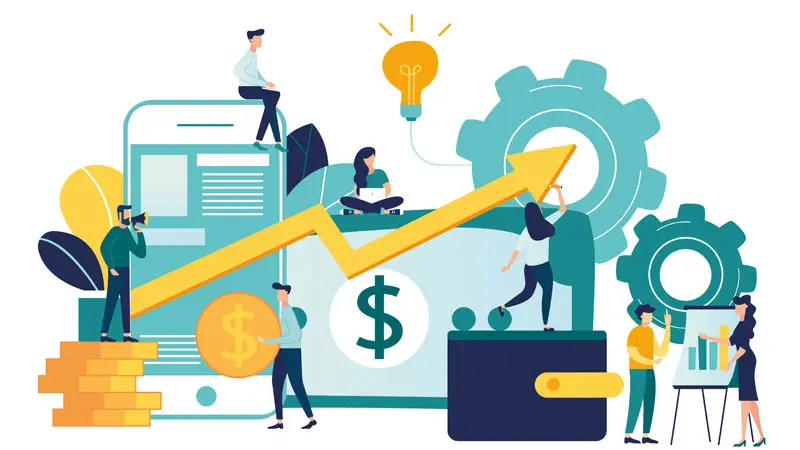- Insights
- Customer Experience
- Article
How customer service is evolving with P2P payments

Whether it’s splitting the bill at a restaurant or paying a small-business vendor, peer-to-peer (P2P) payment technology is streamlining the way we send and receive money. But as its popularity grows, building out the capacity to provide great customer service is critical to gaining — and retaining — users.
There’s no disputing the explosive rise in popularity of P2P payment services in recent years. P2P payment volume on popular app Venmo, for example, has close to tripled since 2015, according to Recode. And, based on findings from Statista, PayPal has seen its yearly mobile-payment volume increase to $106 billion in 2016, growing 55 percent from the previous year.
Overall, P2P payment volume is predicted to reach upwards of $17 billion annually by 2019, according to Forrester, driven by the accessibility of P2P apps, attractive user experiences and the capability of speedy domestic and cross-border transfers. However, this rise in popularity also means P2P payment companies need to find ways to address the unique challenges of delivering top-notch customer support in this space.
How customer service is changing in the P2P payment industry
PayPal has both the blessing and the curse of being the first really successful P2P company, notes Aaron McPherson, an independent payment consultant who previously served as the senior vice-president of global payment strategy at financial-services company FIS.
PayPal’s status is a blessing, because its early foothold on P2P positioned the company to define the market and earn the lion’s share of the profits associated with it. It’s also a curse, because PayPal was among the first to navigate this new P2P space, learning lessons in the process.
One of those lessons is that people still demand great customer service even when they’re paying next to nothing to use the product. This demand for quality service and the profits associated with P2P software are disproportionate, says McPherson. “It illustrates how pricing structure has long been one of those things that continually bedevil the payments space.”
According to McPherson, P2P players have traditionally tried to minimize contact center and support staff, while beefing up online FAQs and self-service capabilities. But that model could be in for a huge upset sooner rather than later as big banks and traditional institutions enter the P2P arena.
With the recent launch of Zelle, a technology company that produces white-label P2P payment apps for the likes of Wells Fargo, big banks that offer P2P apps can bring their substantial customer service resources to people who need support. “The thing about a white-label model like Zelle, is that the payment app connects directly to your bank account,” McPherson says. “There’s no waiting for ACH [automated clearing house] transfers to and from an app, and the customer is dealing with fewer service and support points of contact.”
For the P2P payment industry, consolidation in points-of-service means customers spend less time figuring out who to contact when there’s an issue, improving overall customer satisfaction. This streamlined approach allows P2P providers like Zelle to focus more on innovating and improving their products, while leveraging their banking partners to deliver customer service.
Addressing P2P customer service challenges
P2P payments are on the rise not just due to the convenience it creates for consumers, but because of cost savings it creates for banks.
Cash is actually incredibly expensive for banks to support; think ATMs, bank branches and cash-distribution costs. According to research from Deloitte, it costs about $200 billion a year to support cash and card transactions in the United States. Credit and debit cards are also expensive — notably for merchants, who usually pay for in-store terminals and card transaction fees. Moving transactions from cash to digital results in cost savings that can be passed on to customers.
Along with per-transaction savings, banks are are also looking at P2P payment services as another avenue for customer retention. The level of customer support big banks bring to the P2P space via technologies will likely evolve differently than non-bank players like Venmo. That’s because banks have a multi-generational customer base, and the desire to upsell and cross-sell additional products and services in the future.
In an article entitled “The digital battle that banks must win,” research firm McKinsey noted that the increase in P2P payment technologies is boosting the number of consumer interactions for banks that offer options like Zelle. While standalone services can rely heavily on empowering their majority Millennial users to solve service and technical issues with minimal interaction, banks are dealing with consumers of all demographics who are used to getting a personalized customer service experience. About 25 percent of seniors said they plan to use P2P payment technologies this year, and banks will need to accommodate them if a branded, white-label solution is what they end up using.
Banks may have to forge new paths for digital payments
One of the most common consumer issues for P2P payment companies is users contacting customer service because they either send money to the wrong person, or send the wrong amount of money to the right person. But user errors like these can’t be remedied by customer service; rather, users need to contact the person or party they transacted with to get the money back. It’s something that P2P providers have dealt with from day one, and have prioritized customer education and website FAQs to let people know what they can (and can’t) do.
Big banks on the other hand may have older customers using P2P services for the very first time, like grandparents sending money to their kids for a birthday or to help with college expenses. Banks that are willing to take the time to educate and serve novice P2P app users will likely do a better job of retaining and increasing the lifetime value of those customers.
Providing outstanding customer service to users of P2P payment apps comes with its own set of unique challenges. But according to the experts, the landscape is shifting, with big banks bringing their significant customer service muscle to the game. As competition for users ramps up, P2P providers will likely focus on top-notch self-service and proactive customer education to not just attract more users, but also to make sure they stick around.



